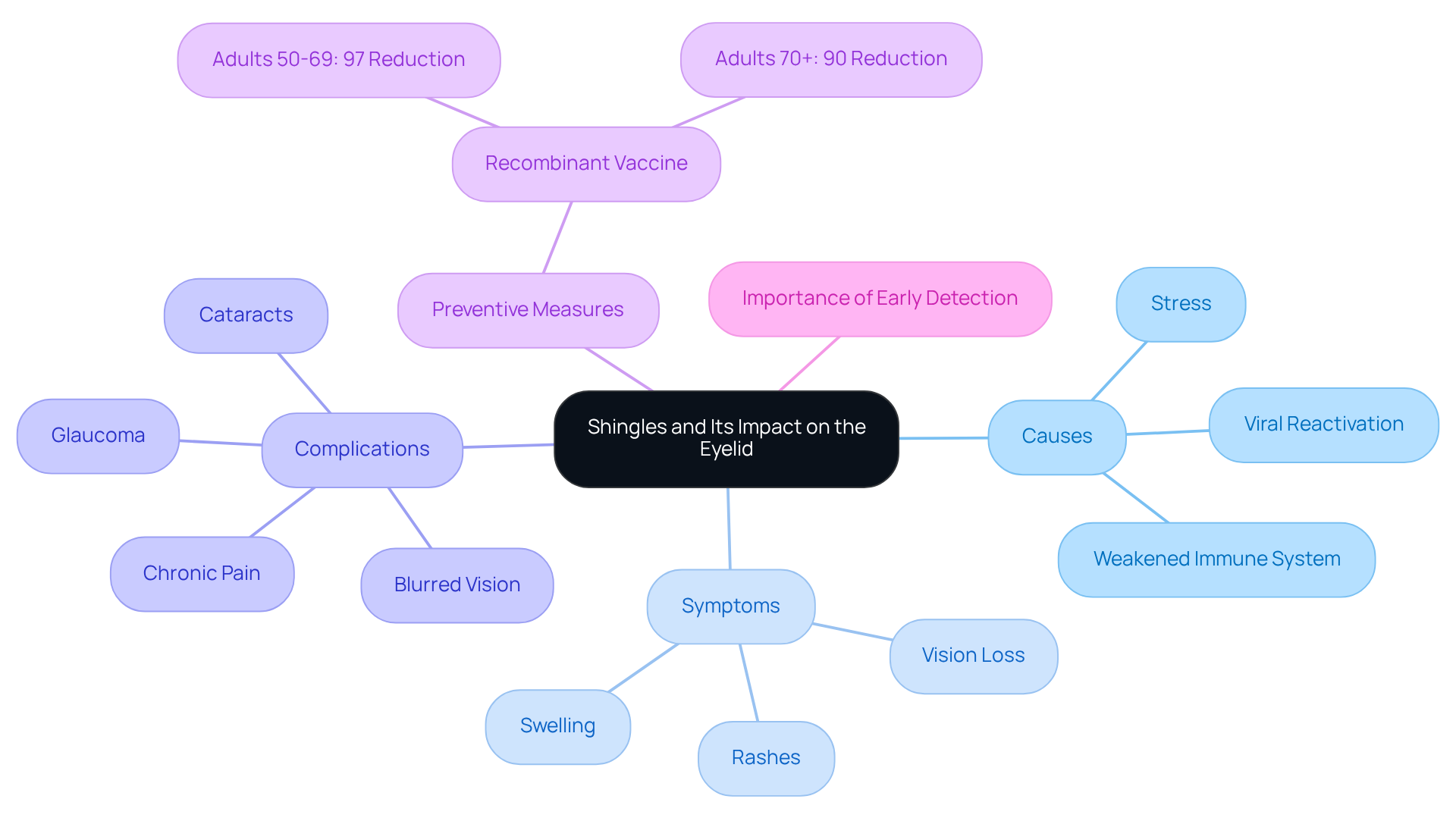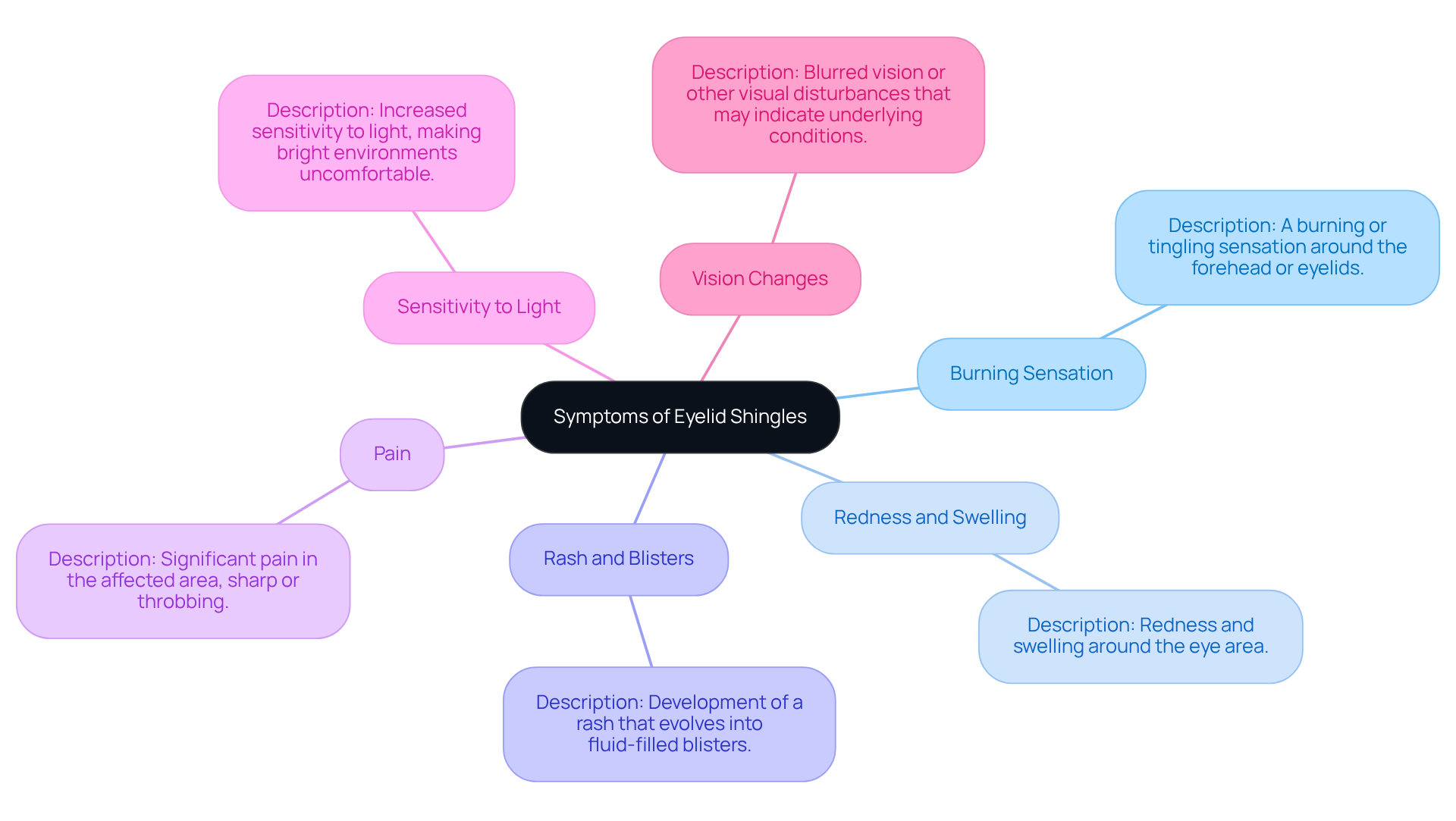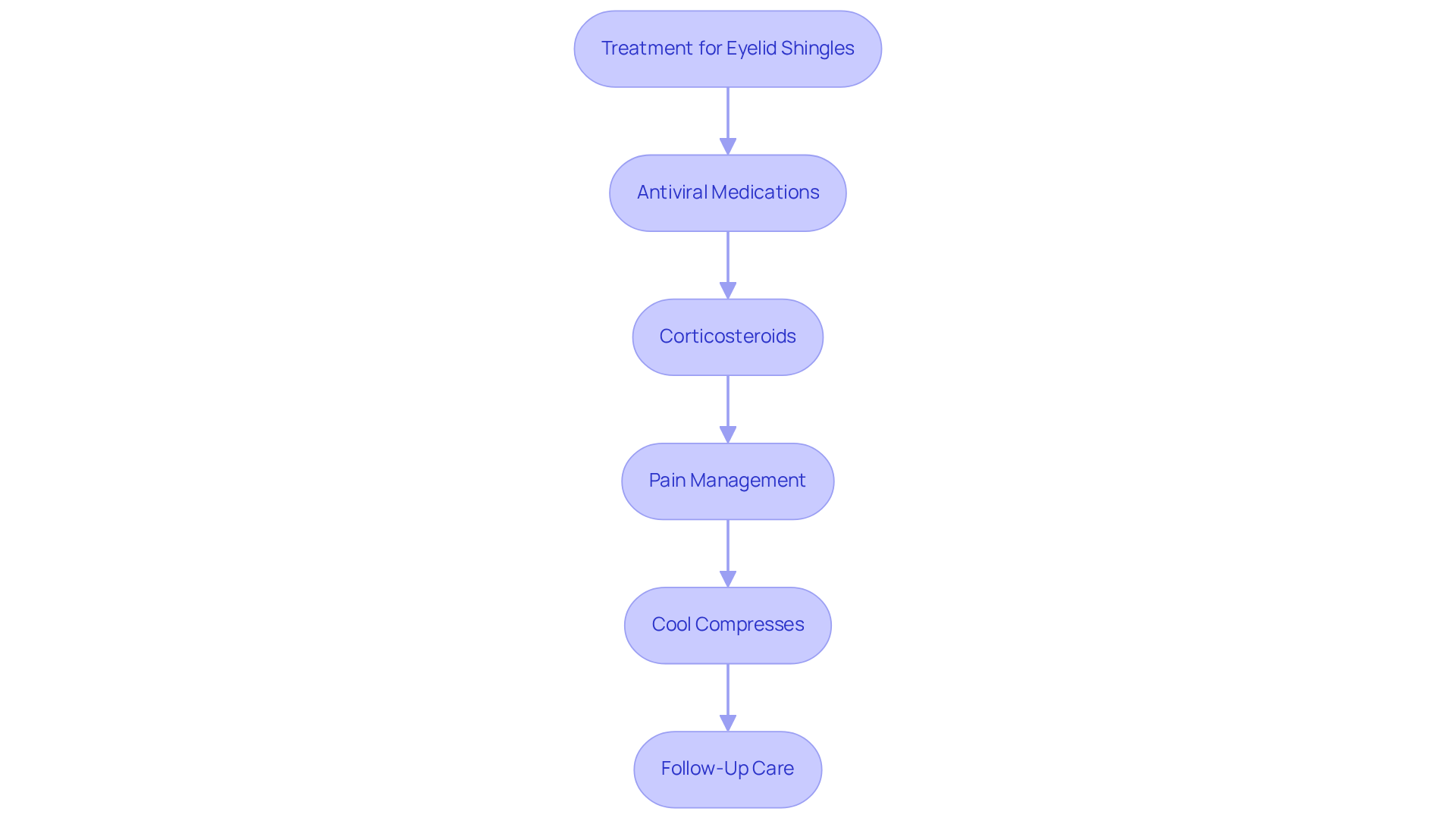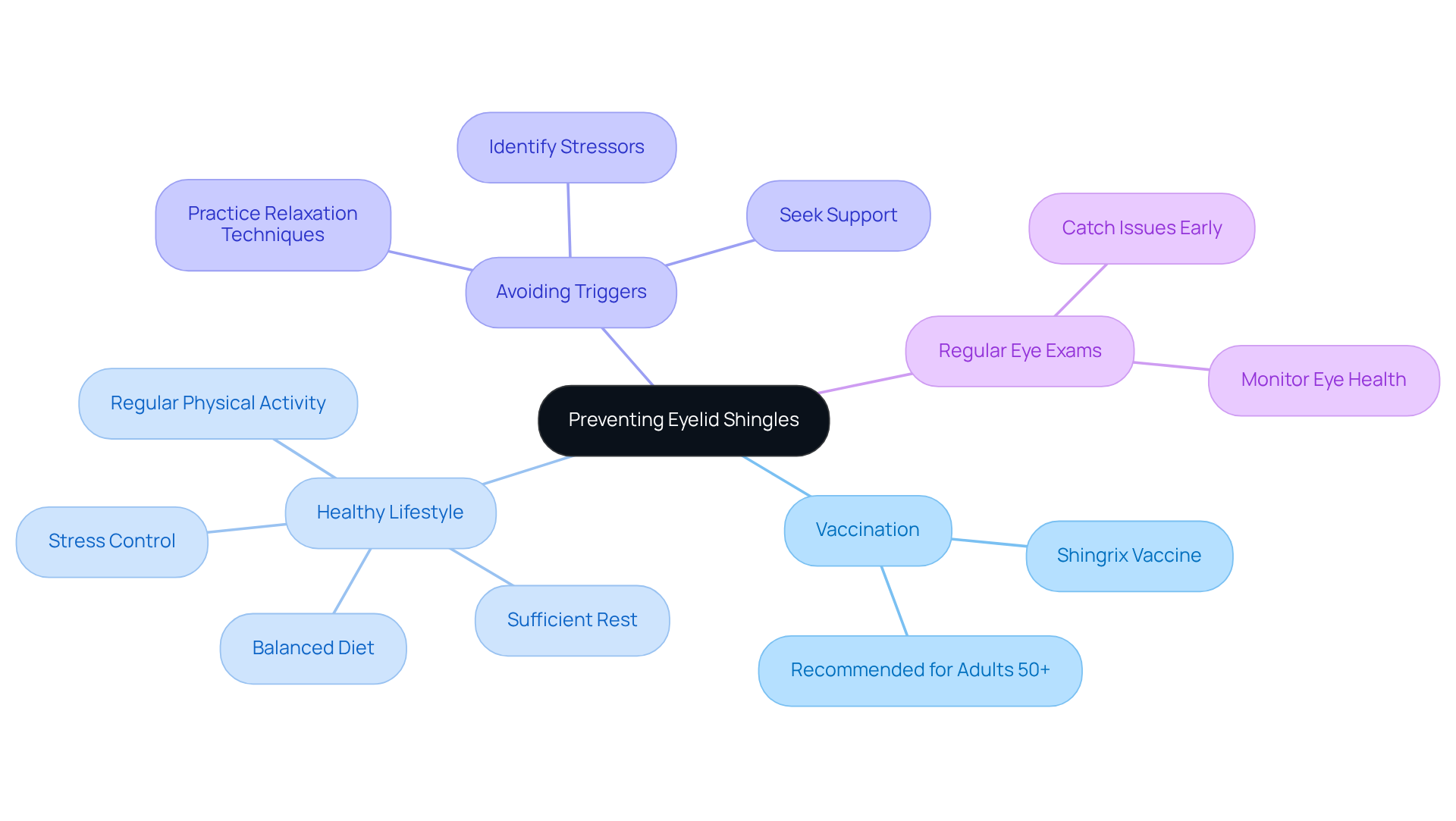Posted by: Northwest Eye in General on October 26, 2025
Overview
Shingles on the eyelid, also known as herpes zoster ophthalmicus, can be a distressing condition. We understand that the thought of painful rashes, swelling, and the possibility of serious complications like vision loss can be overwhelming. It’s common to feel anxious about these symptoms, but early detection and intervention are crucial.
Effective treatment options are available, including antiviral medications that can help manage the condition. Additionally, preventative measures such as vaccination can significantly reduce the risk of developing shingles and its associated complications. We want you to feel reassured that there are steps you can take to protect your health.
Remember, we are here to help you through this process. Seeking prompt care is essential, and by doing so, you can safeguard your vision and overall well-being. Don’t hesitate to reach out for support and guidance.
Introduction
Shingles, a viral infection caused by the varicella-zoster virus, can manifest in concerning ways, especially when it affects the sensitive area around the eyelid. We understand that the potential for painful rashes and serious complications, such as vision loss, can be alarming. It’s essential to grasp this condition to maintain eye health and overall well-being.
This article explores the symptoms, treatment options, and preventive measures for shingles on the eyelid. We hope to raise important questions about how you can safeguard your vision and health against this often-overlooked threat. Remember, you are not alone in this journey, and we are here to help you through the process.
Define Shingles and Its Impact on the Eyelid
Shingles, or herpes zoster, is a viral infection that can understandably cause concern. It results from the reactivation of the varicella-zoster virus, the same virus responsible for chickenpox. After recovering from chickenpox, this virus can remain dormant in nerve tissues and may reactivate later in life. Factors such as stress or a weakened immune system often trigger this reactivation.
When shingles on eyelid affects the area around the eye, it presents as herpes zoster ophthalmicus (HZO). This can lead to painful rashes, swelling, and serious complications, including vision loss if not addressed quickly. We understand that the delicate skin around the eye and its proximity to the organ make it especially vulnerable to the virus’s effects, which is why early detection and intervention are so crucial.
Approximately half of the cases of V1 varicella-zoster virus reactivation involve the eye, leading to conditions like keratitis and uveitis. These conditions can significantly impair vision, and we want to reassure you that there are ways to mitigate these risks. Recent studies indicate that the recombinant herpes zoster vaccine can reduce the risk of developing herpes zoster by about 97% for adults aged 50 to 69 and 90% for those aged 70 and older. This highlights the importance of vaccination as a preventive measure.
Ophthalmologists stress that the appearance of the typical herpes zoster rash is generally diagnostic. If you notice any vesicular lesions in the eye area, including shingles on eyelid, it’s important to seek an ophthalmologic consultation promptly to evaluate possible eye involvement. Early diagnosis and treatment are crucial to mitigate the risk of complications such as chronic pain, glaucoma, cataracts, and blurred vision, which can threaten overall eye health. Remember, we are here to help you through this process.

Identify Symptoms of Eyelid Shingles
The symptoms of shingles on eyelid can vary, and we understand how concerning this can be for you. Typically, these symptoms include:
- Burning Sensation: Many patients report a burning or tingling sensation around the forehead or eyelids, which can feel quite unsettling.
- Redness and Swelling: The area around the eye may become red and swollen, which could indicate shingles on eyelid.
- Rash and Blisters: A rash may develop, often starting as red spots that evolve into fluid-filled blisters, similar to shingles on eyelid. These can appear on the eyelash, forehead, or even the nose, as well as shingles on eyelid.
- Pain: Significant pain in the affected area, like that experienced with shingles on eyelid, is common, and it can feel sharp or throbbing.
- Sensitivity to Light: Increased sensitivity to light (photophobia) may occur in individuals with shingles on eyelid, making bright environments uncomfortable.
- Vision Changes: In some cases, you may notice blurred vision or other visual disturbances, potentially linked to shingles on eyelid. These can signal underlying conditions such as cataracts, diabetic retinopathy, dry eyes, or macular degeneration.
It’s crucial to seek immediate medical attention if you experience these symptoms, as they may be related to shingles on eyelid, and untreated eye conditions can lead to serious health complications. Remember, only a Northwest Eye doctor or eye care professional can provide an accurate diagnosis and appropriate treatment. We are here to help you through this process.

Explore Treatment Options for Eyelid Shingles
Treatment for shingles on eyelid can feel overwhelming, but we are here to help you through this process. Typically, it involves a combination of antiviral medications and supportive care that can provide relief and promote healing:
-
Antiviral Medications: Early intervention with antiviral drugs such as acyclovir, valacyclovir, or famciclovir is crucial. These medications help reduce the severity and duration of the outbreak of shingles on eyelid, providing you with peace of mind during this challenging time.
-
Corticosteroids: In certain instances, corticosteroid eye drops may be recommended to decrease inflammation and swelling in the eye and surrounding area, helping to alleviate discomfort.
-
Pain Management: It’s common to feel discomfort, and over-the-counter pain relievers like ibuprofen or acetaminophen can help. In more severe cases, prescription pain medications may be necessary, and we encourage you to discuss this with your healthcare provider.
-
Cool Compresses: Applying cool, wet cloths to the affected area can provide soothing relief from itching and pain, making your recovery more comfortable.
-
Follow-Up Care: Regular follow-up with an ophthalmologist is essential to monitor for complications, including shingles on eyelid, corneal involvement, or vision changes. We understand that staying on top of your health can feel daunting, but this step is vital for your well-being.
Remember, you are not alone in this journey, and seeking care is a positive step towards recovery.

Implement Prevention Strategies for Eyelid Shingles
Preventing eyelid shingles involves several compassionate strategies:
-
Vaccination: We understand that health concerns can be overwhelming. The shingles vaccine (Shingrix) is highly effective in reducing the risk of developing shingles and its complications. It is recommended for adults aged 50 and older, and we encourage you to consider this important step for your well-being.
-
Healthy Lifestyle: It’s common to feel the weight of daily stressors. Sustaining a robust immune system through a balanced diet, regular physical activity, sufficient rest, and stress control can significantly lower the risk of reactivation. Remember, taking care of yourself is a priority.
-
Avoiding Triggers: We recognize that identifying and managing stressors can be challenging. It’s crucial to be aware of triggers that may lead to herpes zoster reactivation. Practicing relaxation techniques or seeking support during stressful times can make a difference in your mental health.
-
Regular Eye Exams: If you have a history of shingles or are at higher risk, regular eye exams can help monitor your eye health and catch any potential issues early. We are here to help you through this process, ensuring you feel supported every step of the way.

Conclusion
Shingles on the eyelid can be a concerning health issue, but with understanding and timely intervention, it can be effectively managed. We understand that the reactivation of the varicella-zoster virus can lead to symptoms that significantly affect both comfort and vision. Recognizing the signs early, such as burning sensations, redness, and the development of a rash, is crucial for preventing serious complications.
In exploring treatment options, we find that:
- Antiviral medications
- Corticosteroids
- Supportive care
play vital roles in alleviating symptoms and promoting healing. Additionally, preventive measures, like vaccination and maintaining a healthy lifestyle, are essential in reducing the risk of shingles reactivation. Regular eye exams are also recommended for those at higher risk, ensuring that any potential issues can be addressed promptly.
Ultimately, awareness and proactive management are key in dealing with shingles on the eyelid. By prioritizing health through vaccination, recognizing symptoms early, and seeking appropriate care, individuals can protect their vision and overall well-being. Taking these steps not only enhances personal health but also fosters a supportive environment for others dealing with similar concerns. We are here to help you through this process.
Frequently Asked Questions
What is shingles and what causes it?
Shingles, or herpes zoster, is a viral infection caused by the reactivation of the varicella-zoster virus, which is the same virus responsible for chickenpox. After recovering from chickenpox, the virus can remain dormant in nerve tissues and may reactivate later in life, often triggered by factors such as stress or a weakened immune system.
What is herpes zoster ophthalmicus (HZO)?
Herpes zoster ophthalmicus (HZO) occurs when shingles affects the area around the eye, leading to painful rashes, swelling, and potentially serious complications, including vision loss if not addressed quickly.
What are the potential complications of shingles affecting the eyelid?
Complications can include painful rashes, vision loss, keratitis, and uveitis, which can significantly impair vision. Early detection and intervention are crucial to mitigate these risks.
How effective is the herpes zoster vaccine in preventing shingles?
Recent studies indicate that the recombinant herpes zoster vaccine can reduce the risk of developing herpes zoster by about 97% for adults aged 50 to 69 and 90% for those aged 70 and older.
What should I do if I notice symptoms of shingles on my eyelid?
If you notice any vesicular lesions in the eye area, including shingles on the eyelid, it is important to seek an ophthalmologic consultation promptly to evaluate possible eye involvement and to receive early diagnosis and treatment.
What are the risks of not treating shingles on the eyelid?
Not treating shingles on the eyelid can lead to complications such as chronic pain, glaucoma, cataracts, and blurred vision, which can threaten overall eye health. Early diagnosis and treatment are crucial to mitigate these risks.






